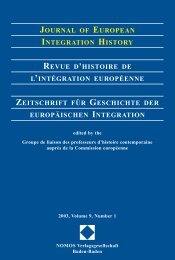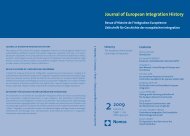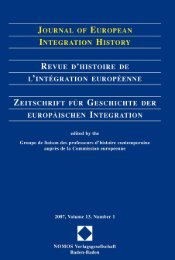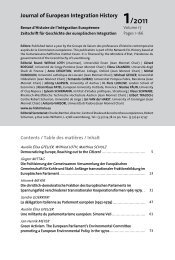journal of european integration history revue d'histoire de l ...
journal of european integration history revue d'histoire de l ...
journal of european integration history revue d'histoire de l ...
You also want an ePaper? Increase the reach of your titles
YUMPU automatically turns print PDFs into web optimized ePapers that Google loves.
54<br />
Tapani Paavonen<br />
least nominally un<strong>de</strong>r the auspices <strong>of</strong> the United Nations (UN), were basically not<br />
problematic. Thus Finland joined the International Monetary Fund and the International<br />
Bank for Reconstruction and Development or World Bank in February 1948<br />
and the GATT in 1949-50.<br />
Soviet policy towards Finland passed through different phases which coinci<strong>de</strong>d<br />
relatively closely with changes in the Soviet lea<strong>de</strong>rship. Up to the end <strong>of</strong> Joseph<br />
Stalin's dictatorship the Soviet attitu<strong>de</strong> was extremely suspicious <strong>of</strong> Finland <strong>de</strong>veloping<br />
any relations with the West. The period <strong>of</strong> Nikita Khrushchev, on the contrary,<br />
was characterised by a responsive attitu<strong>de</strong> towards the Finnish aspirations, provi<strong>de</strong>d<br />
that Finland consequently followed the friendship policy. Un<strong>de</strong>r Leonid<br />
Brezhnev, again, the Soviet Union tightened its control on Finland. In the 1980s,<br />
especially during perestroika, i.e. the reform policy un<strong>de</strong>r Mikhail Gorbachev, the<br />
Soviet Union finally relaxed its control over Finland.<br />
For about the first ten years after World War II, coinciding largely with Juho Kusti<br />
Paasikivi's presi<strong>de</strong>ncy (1946-56), the Finnish foreign-policy orientation can best be<br />
characterised as an en<strong>de</strong>avour towards neutrality within a narrow manoeuvring room.<br />
In the mid-1950s, however, Finland's international position eased consi<strong>de</strong>rably. As<br />
previously mentioned, Finland joined the Nordic Council and, finally, the Soviet Union<br />
also enabled Finland's membership in the UN. In early 1956 the Soviet Union abandoned,<br />
prematurely, the Porkkala naval base. This change coinci<strong>de</strong>d with the beginning<br />
<strong>of</strong> Urho Kekkonen's long-time presi<strong>de</strong>ncy (1956-81). As the result <strong>of</strong> these changes,<br />
from 1956 onwards the Finnish foreign-policy orientation has openly been called a<br />
neutrality policy, known also as the Paasikivi-Kekkonen Line.<br />
The self-ma<strong>de</strong> <strong>de</strong>pen<strong>de</strong>nce on the Soviet Union as the result <strong>of</strong> seeking Soviet<br />
support for the purposes <strong>of</strong> internal political struggles became crucial for Finland's<br />
international positioning. Presi<strong>de</strong>nt Kekkonen's practice, which found a large<br />
number <strong>of</strong> followers was most notorious. Kekkonen was an agrarian politician who<br />
based his post-war political career on the <strong>de</strong>velopment <strong>of</strong> Soviet relations. As the<br />
Presi<strong>de</strong>nt <strong>of</strong> the Republic, Kekkonen closely linked Finland's foreign policy to the<br />
Soviet Union's consent. He consulted the Soviet Union about every major <strong>de</strong>cision.<br />
This meant that, while the Finnish position towards cooperation with the West was<br />
<strong>de</strong>fined on a broad basis within corporatist structures representing all important interest<br />
groups, <strong>de</strong>cisive negotiations with Soviet representatives were conducted in a<br />
narrow circle, between Presi<strong>de</strong>nt Kekkonen and the respective Soviet lea<strong>de</strong>r as a<br />
last resort. During his first term, i.e. 1956-62, Kekkonen's position was extremely<br />
disputed but with the consolidation <strong>of</strong> his power position consent with the Soviet<br />
Union became the generally recognised political wisdom <strong>of</strong> the Finnish statecraft.<br />
An integral part <strong>of</strong> the good-neighbour relations was the flourishing Finnish-Soviet<br />
tra<strong>de</strong>, which was based on a bilateral basis until 1990. From 1945 to 1990 tra<strong>de</strong> with the<br />
Soviet Union covered in average sixteen per cent, sporadically even a quarter, <strong>of</strong> Finland's<br />
total foreign tra<strong>de</strong>. Such volumes would hardly have been possible without the<br />
special political relationship between the two countries. For Finland, bilateral tra<strong>de</strong> with<br />
the Soviet Union formed an element <strong>of</strong> international protectionism, exempting the

















